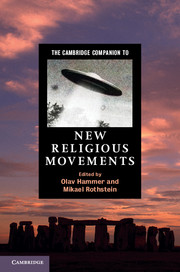Book contents
- Frontmatter
- Introduction to new religious movements
- Part I Social science perspectives
- Part II Themes
- Part III New religious movements
- 8 Scientology: up stat, down stat
- 9 Neopaganism
- 10 The International Raëlian Movement
- 11 The Sathya Sai Baba movement
- 12 Neo-Sufism
- 13 Satanism
- 14 Theosophy
- 15 The New Age
- 16 “Jihadism” as a new religious movement
- 17 New religious movements in changing Russia
- 18 New religious movements in sub-Saharan Africa
- Index
- Other titles in the series
17 - New religious movements in changing Russia
from Part III - New religious movements
Published online by Cambridge University Press: 28 September 2012
- Frontmatter
- Introduction to new religious movements
- Part I Social science perspectives
- Part II Themes
- Part III New religious movements
- 8 Scientology: up stat, down stat
- 9 Neopaganism
- 10 The International Raëlian Movement
- 11 The Sathya Sai Baba movement
- 12 Neo-Sufism
- 13 Satanism
- 14 Theosophy
- 15 The New Age
- 16 “Jihadism” as a new religious movement
- 17 New religious movements in changing Russia
- 18 New religious movements in sub-Saharan Africa
- Index
- Other titles in the series
Summary
The proliferation of NRMs in post-Soviet Russia after several decades of state-imposed atheism and secularism represents a particularly compelling case for thinking about their social and cultural provenance and of the effects of their presence on society. This chapter puts the discussion about NRMs into historical and social context. It argues that Soviet modernization paradoxically created conditions for new forms of religiosity and also contributed to post-Soviet society witnessing one of the most salient examples of “cult controversies.” It provides a general overview of the Russian new religious scene and suggests possible directions of research, implying that focusing on these unconventional religious groups provides intriguing opportunities for understanding Soviet and post-Soviet versions of modern society.
UNINTENDED EFFECTS OF SOVIET MODERNITY: TRANSFORMATION OF RELIGION
One fruitful approach to understanding the provenance of the post-Soviet new religious scene is to examine some unintended consequences of the communist modernizing project. The Bolsheviks translated Marx's vision of the ultimately just, prosperous, and enlightened society into a breakthrough modernization that involved a great amount of violence, including towards religious believers and institutions. Impatient with waiting for the “opium of the people” to become redundant through the advancement of purely secular, rational, and scientific ways of seeing the world, militant atheism engaged in mass closures of religious associations, educational establishments, and places of worship, compounded by pervasive state surveillance of religious activities and believers. There is little doubt that, despite periodic “thaws,” these policies severely undermined the transmission of traditional religious cultures.
- Type
- Chapter
- Information
- The Cambridge Companion to New Religious Movements , pp. 286 - 302Publisher: Cambridge University PressPrint publication year: 2012
- 3
- Cited by

